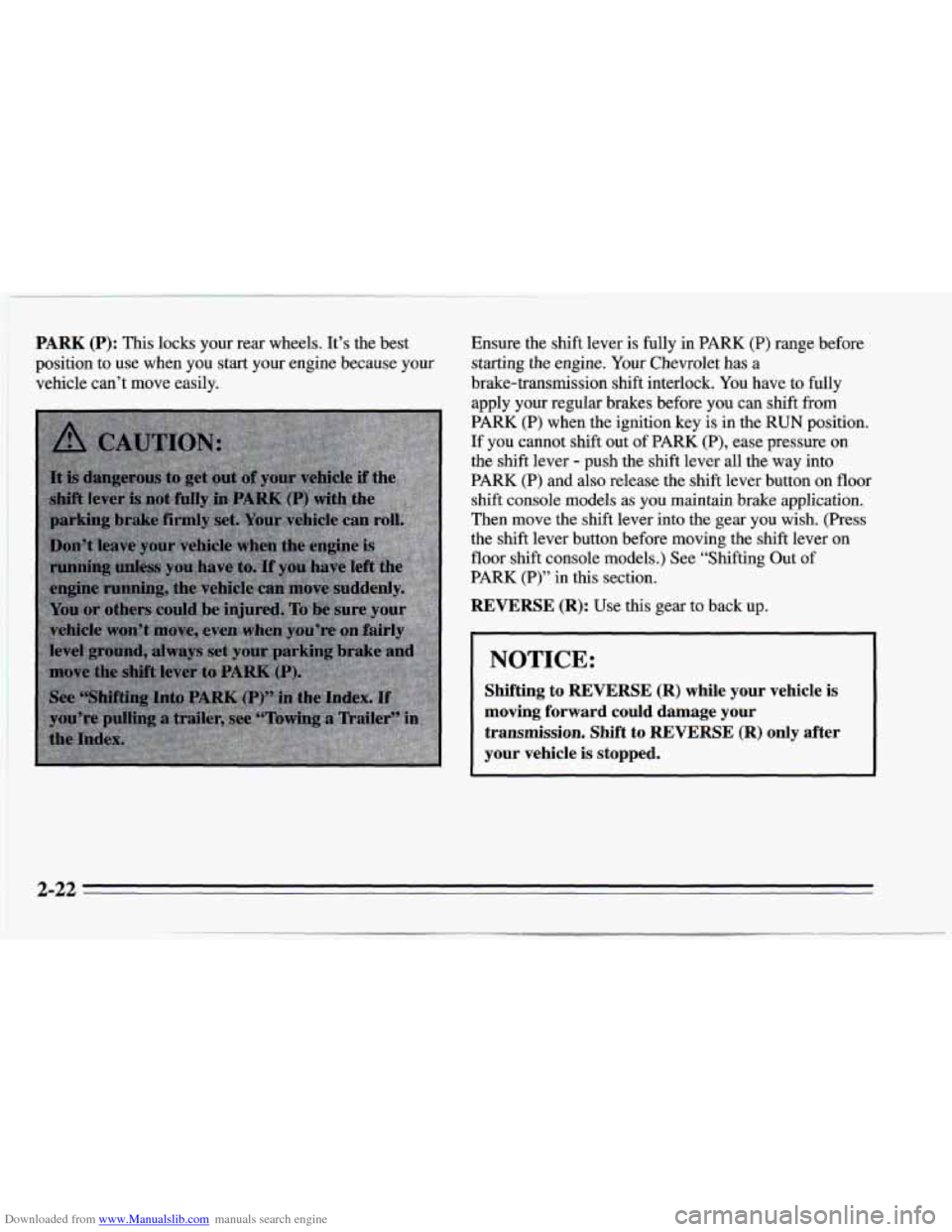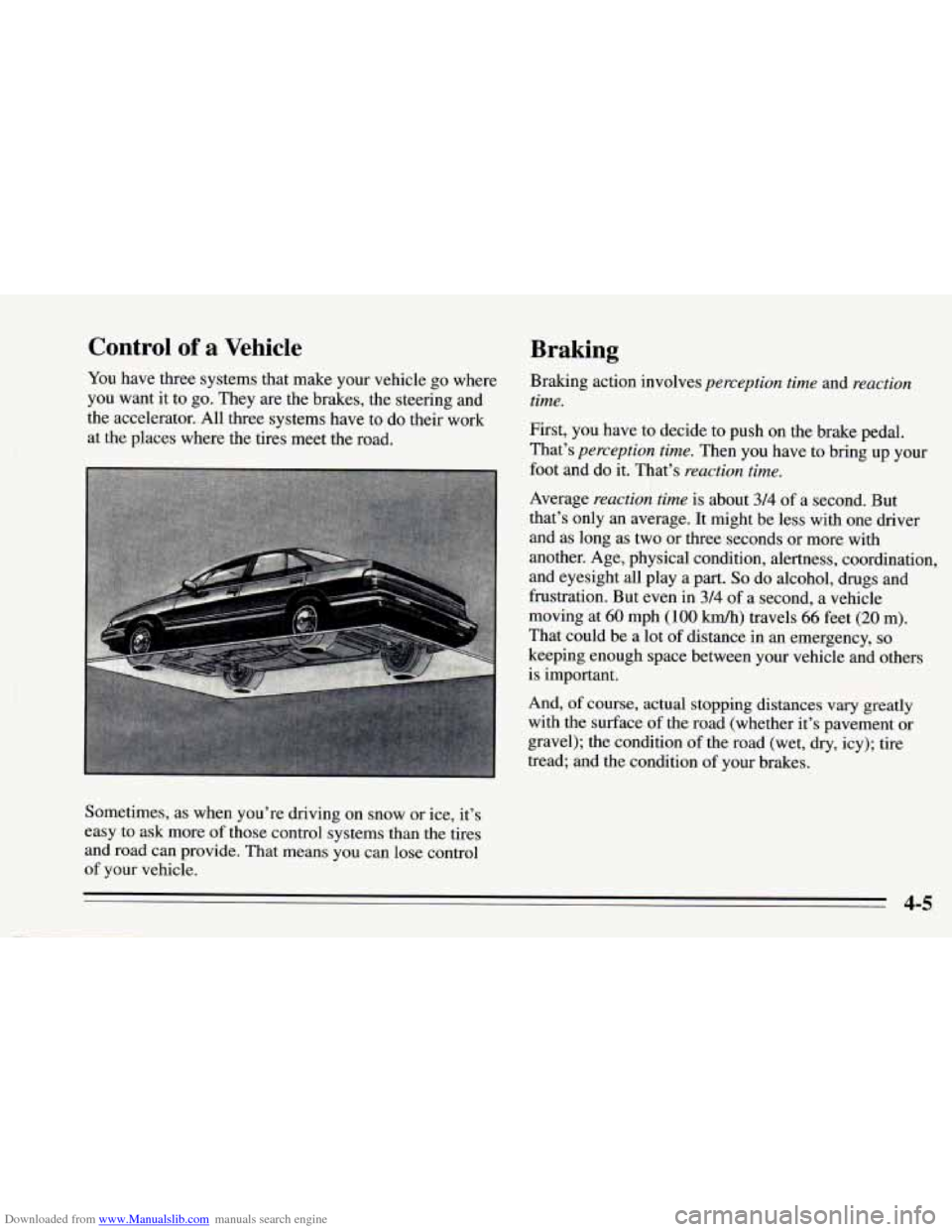Page 74 of 388

Downloaded from www.Manualslib.com manuals search engine PARK (P): This locks your rear wheels. It’s the best
position to use when you start your engine because your
vehicle can’t move easily. Ensure the
shift lever is fully in PARK (P) range before
starting the engine.
Your Chevrolet has a
brake-transmission shift interlock. You have to fully
apply your regular brakes before you can shift
from
PARK (P) when the ignition key is in the RUN position.
If you cannot shift out of PARK (P), ease pressure on
the shift lever
- push the shift lever all the way into
PARK
(P) and also release the shift lever button on floor
shift console models as you maintain brake application.
Then move the shift lever into the gear you wish.
(Press
the shift lever button before moving the shift lever on
floor shift console models.) See “Shifting Out
of
PARK (P)” in this section.
REVERSE (R): Use this gear to back up.
NOTICE:
Shifting to REVERSE (R) while your vehicle is
moving forward could damage your transmission. Shift to REVERSE
(R) only after
your vehicle is
stopped.
2-22
Page 76 of 388

Downloaded from www.Manualslib.com manuals search engine THIRD (D): This is like @, but you never go into
Overdrive.
Here are some times you might choose
D instead of 0:
- When driving on hilly, winding roads
- When towing a trailer, so there is less shifting
between gears
- When going down a steep hill
SECOND
(2): This position gives you more power but
lower fuel economy. You can use
SECOND (2) on hills.
It can help control your speed as you go down steep
mountain roads, but then you would also want to use
your brakes
off and on.
NOTICE:
Don’t drive in SECOND (2) for more than
5 miles (8 km), or at speeds over 55 mph
~ (88 km/h), or you can damage your transmission.
Use
@ or DRIVE (D) as much as possible.
Don’t shift into SECOND
(2) unless you are going
slower than
65 mph (105 kd), or you can
damage your engine.
FIRST (1): This position gives you even more power
(but lower fuel economy) than
SECOND (2). You can
use it on very steep hills, or in deep snow or mud.
If the
selector lever is put in
FIRST (1) the transmission won’t
shift into first gear until the vehicle is going slowly
enough.
I NOTICE:
If your rear wheels can’t rotate, don’t try to
drive. This might happen if you were stuck in
very deep sand or mud
or were up against a solid
object.
You could damage your transmission.
Also, if you stop when going uphill, don’t hold
your vehicle there with only the accelerator
pedal. This could overheat and damage the
transmission. Use your brakes or shift into
PARK (P) to hold your vehicle in position on
a hill.
Maximum engine speed is limited to protect driveline
components from improper operation.
2-24
Page 81 of 388
Downloaded from www.Manualslib.com manuals search engine NOTICE:
If you skip more than one gear when you
downshift, or if you race the engine when you
downshift, you can damage the clutch or
transmission.
Limited-Slip Rear Axle
If you have this feature, your rear axle can give you
additional traction on snow, mud, ice, sand or gravel. It
works like a standard axle most
of the time, but when
one of the rear wheels has no traction and the other does,
the limited-slip feature will allow
the wheel with
traction to move the vehicle.
Parking
Parking Brake
The parking brake uses the brakes on the rear wheels.
To set the parking brake: Hold the brake pedal down
and
pull up on the parking brake lever. If the ignition is
on, the brake system warning light will come on.
2-29
Page 82 of 388
Downloaded from www.Manualslib.com manuals search engine To release the parking brake:Hold the brake pedal
down. Pull the parking brake lever
up until you can push
in the release button. Hold the release button in as you
move the brake lever
all the way down.
I NOTICE:
Driving with the parking brake on can cause
your rear brakes to overheat. You
may have to
replace them, and you could also damage other
parts
of your vehicle.
If you are towing a trailer and are parking on any
hill: See “Towing a Trailer”
in the Index. That section
shows what to do first to keep the trailer from moving.
Page 94 of 388
Downloaded from www.Manualslib.com manuals search engine Cruise Control (Option)
With cruise control, you can maintain a speed of about
25 mph (40 km/h) or more without keeping your foot on
the accelerator. This can really help on long trips. Cruise
control does not work at speeds below about
25 mph
(40 km/h).
When you apply your brakes, or push the clutch pedal, if
you have a manual transmission, the cruise control shuts
Off.
If your vehicle is in cruise control when the optional
ASR System begins to limit wheel spin, the cruise
control will automatically disengage. (See
“ASR
System’’ in the Index). When road conditions allow you
to safely use it again,
you may turn the cruise back on.
3 A3
Page 122 of 388
Downloaded from www.Manualslib.com manuals search engine The brake system warning light will also come on when
you set your parking brake, and it will stay
on if your
parking brake doesn’t release fully. If it stays
on after
your parking brake is fully released, it means you have a
brake problem.
Anti-Lock Brake System Warning Light
INOP
With the anti-lock brake system, this light will come on
when
you start your engine and it will stay on for three
seconds. That’s normal. If the light doesn’t come
on,
have it fixed so it will be ready to warn you if there is a
problem.
If the light flashes
when you’re driving, you don’t have
anti-lock brakes and there could be a problem with your
regular brakes. Pull off the road and stop carefully. You
may notice that the pedal is harder to push. Or, the pedal
may go closer
to the floor. It may take longer to stop.
Have
the vehicle towed for service. (See “Towing Your
Car” in the Index.)
2-70
Page 123 of 388

Downloaded from www.Manualslib.com manuals search engine If the anti-lock brake system warning light stays on
longer than normal after you’ve started your engine, turn
the ignition off. Or, if the light comes
on and stays on
when you’re driving, stop as soon as possible and turn
the ignition off. Then start the engine again to reset the
system.
If the light still stays on, or comes on again
while you’re driving, your Chevrolet needs service. If
the light is on but
not flashing and the regular brake
system warning light isn’t on, you still have brakes, but
you don’t have anti-lock brakes.
ASR (Acceleration Slip Regulation) System
Warning Light (Option)
ASR
OFF
This warning light should come on briefly as you start
the engine.
If the warning light doesn’t come on then,
have it fixed
so it will be ready to warn you if there’s a
problem. If it stays on, or comes
on when you’re
driving, there may be a problem with your
ASR system
and your vehicle may need service. When this warning
light is on, the system will not limit wheel spin. Adjust
your driving accordingly.
If your brakes begin
to overheat, the brake portion of the
ASR system will shut down, but the throttle and engine
spark control will continue to work. The warning light
will not come on when this happens.
2-71
Page 161 of 388

Downloaded from www.Manualslib.com manuals search engine Control of a Vehicle
You have three systems that make your vehicle go where
you want it to go. They are the brakes, the steering and
the accelerator. All three systems have to do their work
at the places where the tires meet the road.
Sometimes, as when you’re driving on snow or ice, it’s
easy to ask more of those control systems than the tires
and road can provide. That means you can lose control
of your vehicle.
Braking
Braking action involves perception time and reaction
time.
First, you have to decide to push on the brake pedal.
That’s
perception time. Then you have to bring up your
foot and do it. That’s
reaction time.
Average reaction time is about 314 of a second. But
that’s only an average. It might be less with one driver
and as long as two or three seconds or more with
another. Age, physical condition, alertness, coordination,
and eyesight all play a part.
So do alcohol, drugs and
frustration. But even in
314 of a second, a vehicle
moving at
60 mph (100 km/h) travels 66 feet (20 m).
That could be a lot of distance in an emergency,
so
keeping enough space between your vehicle and others
is important.
And, of course, actual stopping distances
vary greatly
with the surface of the road (whether it’s pavement
or
gravel); the condition of the road (wet, dry, icy); tire
tread; and the condition of your brakes.
4-5